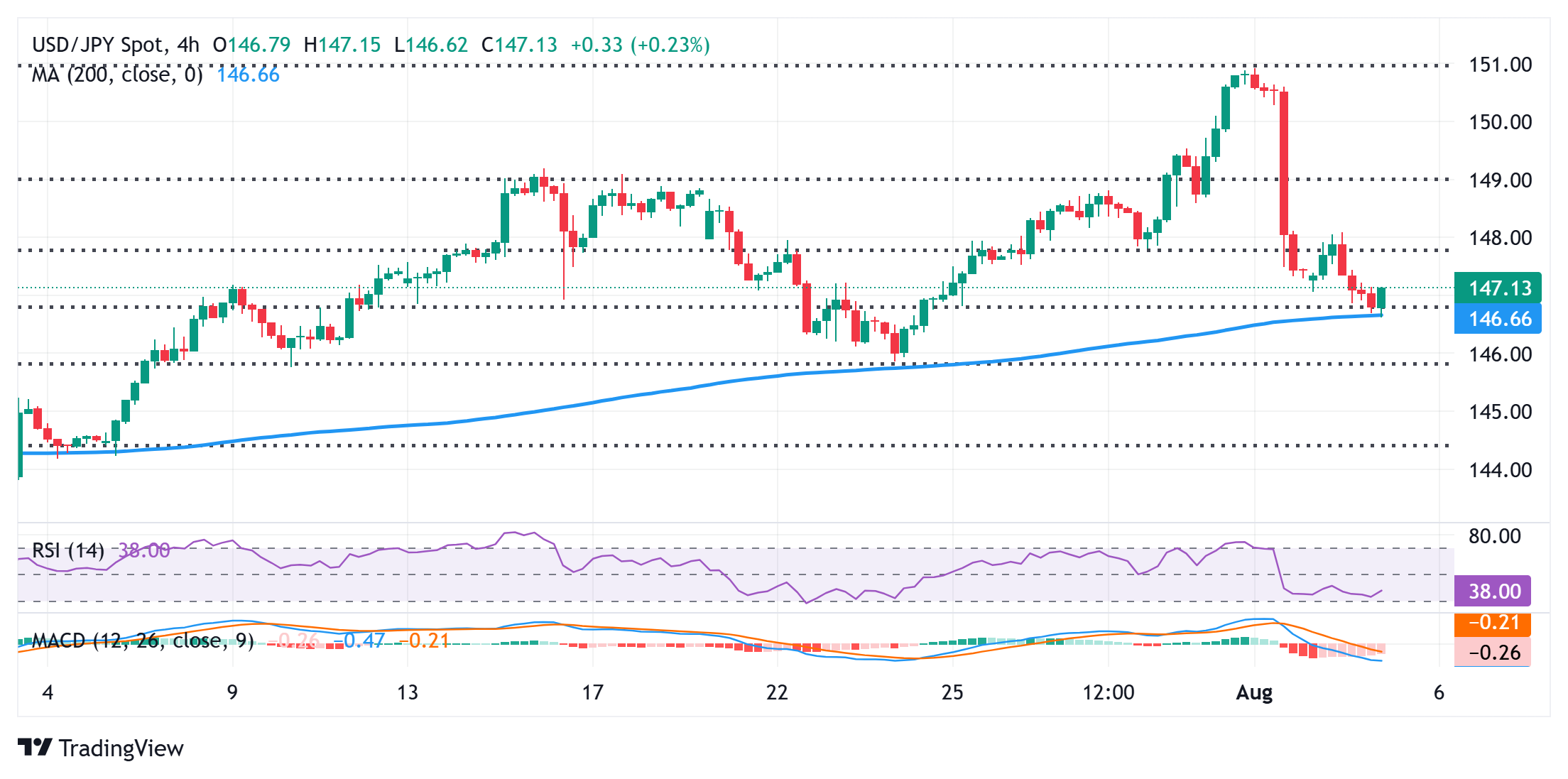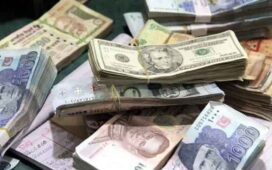- The Japanese Yen struggles to capitalize on modest Asian session gains against the rebounding USD.
- Hawkish June BoJ meeting Minutes reaffirmed rate hike bets and should limit the JPY downside.
- Rising September Fed rate cut bets could act as a headwind for the USD and cap the USD/JPY pair.
The Japanese Yen (JPY) retreats after touching a nearly two-week high against a broadly rebounding US Dollar (USD) during the Asian session on Tuesday, pushing the USD/JPY pair further beyond the 147.00 mark in the last hour. Investors now seem convinced that domestic political uncertainty could complicate the Bank of Japan’s (BoJ) policy normalization path amid signs of cooling inflation in Japan. This, along with the upbeat market mood, is seen undermining the JPY’s safe-haven status.
Meanwhile, the June BoJ meeting minutes released earlier today reaffirmed bets for an imminent interest rate hike by the year-end. Adding to this, an upward revision of Japan’s Services PMI should help limit deeper JPY losses. Meanwhile, the growing acceptance that the Federal Reserve (Fed) will resume its rate-cutting cycle in September could act as a headwind for the USD. This might further contribute to capping the upside for the USD/JPY pair and warrants some caution for bulls.
Japanese Yen bulls turn cautious amid receding safe-haven demand, modest USD strength
- The Bank of Japan, in the Minutes of the June meeting released this Tuesday, reiterated that it will hike interest rates further if growth and inflation continue to advance in line with its estimates. The minutes also revealed that most BoJ members supported keeping interest rates unchanged for the time being amid heightened uncertainty over US trade tariffs.
- The S&P Global Japan Services PMI rose to 53.6 in July 2025, slightly above the flash estimate of 53.5 and up from 51.7 in the previous month, marking the fourth straight month of expansion and the fastest pace since February. Moreover, the composite PMI rose slightly to 51.6 last month, marking the strongest overall business activity growth since February.
- The ruling Liberal Democratic Party’s loss in the July 20 polls fueled concerns about Japan’s fiscal health amid calls from the opposition to boost spending and cut taxes. This suggests that prospects for BoJ rate hikes could be delayed further. Moreover, BoJ Governor Kazuo Ueda last week downplayed inflation risks and signaled continued policy patience.
- Asian equity markets take cues from the overnight sharp rebound on Wall Street and scale higher during the Asian session on Tuesday. This, in turn, undermines demand for traditional safe-haven assets and contributes to capping the Japanese Yen. The US Dollar, on the other hand, gains some positive traction and further offers some support to the USD/JPY pair.
- Any meaningful USD appreciation seems elusive in the wake of the growing acceptance that the Federal Reserve will resume its rate-cutting cycle in September. The bets were lifted by Friday’s weaker-than-expected US Nonfarm Payrolls report, which pointed to a cooling labor market. Moreover, concerns about the Fed’s independence warrant caution for the USD bulls.
- US President Donald Trump ordered the firing of the head of the Bureau of Labor Statistics hours after the dismal employment details. Moreover, Fed Governor Adriana Kugler resigned from her position on the central bank’s board. This comes amid relentless political pressure on Fed Chair Jerome Powell to lower borrowing costs and should keep a lid on the USD.
- Meanwhile, the CME Group’s FedWatch Tool implies over 80% chance of a Fed rate cut in September and around 65 basis points of easing by the end of this year. This keeps US Treasury bond yields depressed and weighs on the USD, which, in turn, might act as a headwind for the USD/JPY pair and warrant some caution before positioning for any meaningful recovery.
- Traders now look forward to the release of the US ISM Services PMI for a fresh impetus later during the North American session. Apart from this, comments from influential FOMC members will play a key role in driving the USD demand. This, along with the broader risk sentiment, should produce short-term trading opportunities around the USD/JPY pair.
USD/JPY needs to surpass 147.35 immediate hurdle to back the case for further intraday gains

From a technical perspective, spot prices showed some resilience below the 50% retracement level of the rally from the July swing low, and the subsequent move back above the 147.00 mark warrants caution for the USD/JPY bears. Meanwhile, neutral oscillators on the daily chart suggest that any further recovery is more likely to confront an immediate hurdle near the 147.35 area ahead of the 147.75 region, or the 38.2% Fibonacci retracement level and the 148.00 round figure. A sustained strength beyond the latter will suggest that the USD/JPY pair has formed a near-term bottom and shift the bias in favor of bullish traders.
On the flip side, the 50% retracement level, around the 146.85 region, now seems to act as an immediate support. Some follow-through selling below the Asian session low, around the 146.60 area, could make the USD/JPY pair vulnerable to accelerate the fall towards the 146.00 mark. The downward trajectory could extend further and eventually drag spot prices to the 145.85 zone, or the 61.8% Fibo. retracement level.
Risk sentiment FAQs
In the world of financial jargon the two widely used terms “risk-on” and “risk off” refer to the level of risk that investors are willing to stomach during the period referenced. In a “risk-on” market, investors are optimistic about the future and more willing to buy risky assets. In a “risk-off” market investors start to ‘play it safe’ because they are worried about the future, and therefore buy less risky assets that are more certain of bringing a return, even if it is relatively modest.
Typically, during periods of “risk-on”, stock markets will rise, most commodities – except Gold – will also gain in value, since they benefit from a positive growth outlook. The currencies of nations that are heavy commodity exporters strengthen because of increased demand, and Cryptocurrencies rise. In a “risk-off” market, Bonds go up – especially major government Bonds – Gold shines, and safe-haven currencies such as the Japanese Yen, Swiss Franc and US Dollar all benefit.
The Australian Dollar (AUD), the Canadian Dollar (CAD), the New Zealand Dollar (NZD) and minor FX like the Ruble (RUB) and the South African Rand (ZAR), all tend to rise in markets that are “risk-on”. This is because the economies of these currencies are heavily reliant on commodity exports for growth, and commodities tend to rise in price during risk-on periods. This is because investors foresee greater demand for raw materials in the future due to heightened economic activity.
The major currencies that tend to rise during periods of “risk-off” are the US Dollar (USD), the Japanese Yen (JPY) and the Swiss Franc (CHF). The US Dollar, because it is the world’s reserve currency, and because in times of crisis investors buy US government debt, which is seen as safe because the largest economy in the world is unlikely to default. The Yen, from increased demand for Japanese government bonds, because a high proportion are held by domestic investors who are unlikely to dump them – even in a crisis. The Swiss Franc, because strict Swiss banking laws offer investors enhanced capital protection.





